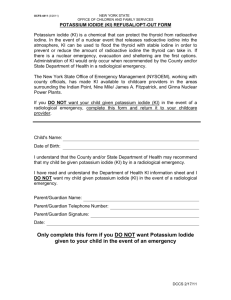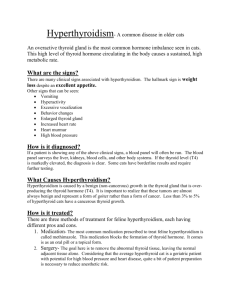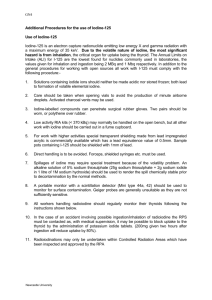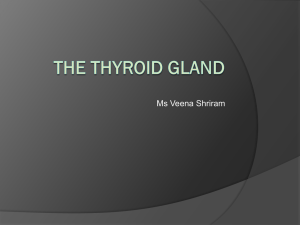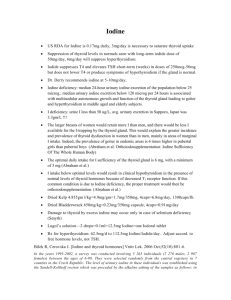Thyroid Storm
advertisement
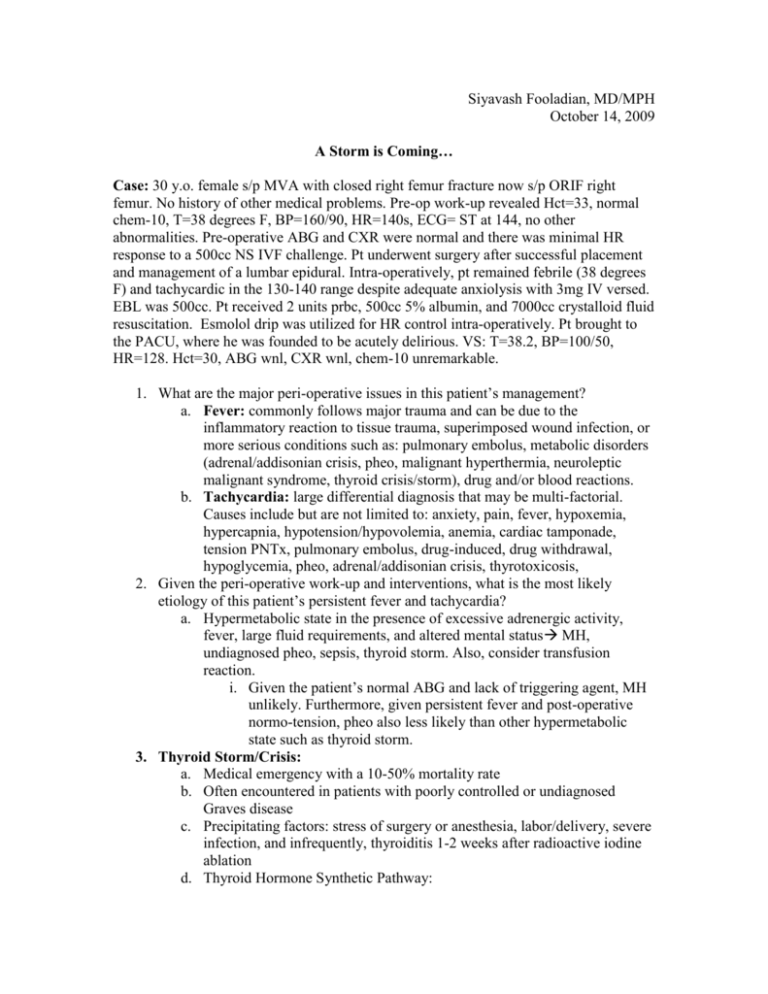
Siyavash Fooladian, MD/MPH October 14, 2009 A Storm is Coming… Case: 30 y.o. female s/p MVA with closed right femur fracture now s/p ORIF right femur. No history of other medical problems. Pre-op work-up revealed Hct=33, normal chem-10, T=38 degrees F, BP=160/90, HR=140s, ECG= ST at 144, no other abnormalities. Pre-operative ABG and CXR were normal and there was minimal HR response to a 500cc NS IVF challenge. Pt underwent surgery after successful placement and management of a lumbar epidural. Intra-operatively, pt remained febrile (38 degrees F) and tachycardic in the 130-140 range despite adequate anxiolysis with 3mg IV versed. EBL was 500cc. Pt received 2 units prbc, 500cc 5% albumin, and 7000cc crystalloid fluid resuscitation. Esmolol drip was utilized for HR control intra-operatively. Pt brought to the PACU, where he was founded to be acutely delirious. VS: T=38.2, BP=100/50, HR=128. Hct=30, ABG wnl, CXR wnl, chem-10 unremarkable. 1. What are the major peri-operative issues in this patient’s management? a. Fever: commonly follows major trauma and can be due to the inflammatory reaction to tissue trauma, superimposed wound infection, or more serious conditions such as: pulmonary embolus, metabolic disorders (adrenal/addisonian crisis, pheo, malignant hyperthermia, neuroleptic malignant syndrome, thyroid crisis/storm), drug and/or blood reactions. b. Tachycardia: large differential diagnosis that may be multi-factorial. Causes include but are not limited to: anxiety, pain, fever, hypoxemia, hypercapnia, hypotension/hypovolemia, anemia, cardiac tamponade, tension PNTx, pulmonary embolus, drug-induced, drug withdrawal, hypoglycemia, pheo, adrenal/addisonian crisis, thyrotoxicosis, 2. Given the peri-operative work-up and interventions, what is the most likely etiology of this patient’s persistent fever and tachycardia? a. Hypermetabolic state in the presence of excessive adrenergic activity, fever, large fluid requirements, and altered mental status MH, undiagnosed pheo, sepsis, thyroid storm. Also, consider transfusion reaction. i. Given the patient’s normal ABG and lack of triggering agent, MH unlikely. Furthermore, given persistent fever and post-operative normo-tension, pheo also less likely than other hypermetabolic state such as thyroid storm. 3. Thyroid Storm/Crisis: a. Medical emergency with a 10-50% mortality rate b. Often encountered in patients with poorly controlled or undiagnosed Graves disease c. Precipitating factors: stress of surgery or anesthesia, labor/delivery, severe infection, and infrequently, thyroiditis 1-2 weeks after radioactive iodine ablation d. Thyroid Hormone Synthetic Pathway: Thyroid hormone synthesis includes the following steps: (1) iodide (I-) trapping by the thyroid follicular cells; (2) diffusion of iodide to the apex of the cells; (3) transport of iodide into the colloid; (4) oxidation of inorganic iodide to iodine and incorporation of iodine into tyrosine residues within thyroglobulin molecules in the colloid; (5) coupling of two diiodotyrosine (DIT) molecules to form tetraiodothyronine (thyroxine, T4) or of monoiodotyrosine (MIT) with DIT to form triiodothyronine (T3); (6) uptake of thyroglobulin from the colloid into the follicular cell by endocytosis, fusion of the thyroglobulin with a lysosome, and proteolysis and release of T4, T3, DIT, and MIT; (7) release of T4 and T3 into the circulation; and (8) deiodination of DIT and MIT to yield tyrosine. T3 is also formed from monodeiodination of T4 in the thyroid and in peripheral. *UpToDate, Thyroid Hormone Biosynthesis. Retrieved on October 10, 2009. e. Signs/Symptoms: i. Early symptoms include nausea/vomiting, heat intolerance with profuse sweating, and diarrhea ii. Fever iii. Tachycardia iv. Mental status changes (irritability, delirium, coma) v. Atrial or ventricular arrhythmias, particularly Afib vi. Hypertension often precedes hypotension vii. Congestive heart failure (25% of cases) f. Management: directed toward reversing crisis and complications i. IV Steroids: dexamethasone 10mg IV, then 2mg q6hrs 1. Inhibits synthesis, release, and peripheral conversion of T4T3 (active) 2. Prevent occurrence of relative adrenal insufficiency secondary to hypermetabolic state ii. Propylthiouracil (PTU): 1. 600mg PO/NGT, then 200mg PO/NGT q2hrs 2. Inhibits synthesis of thyroid hormone by blocking the enzyme, thyroid peroxidase (steps 3-5 in above diagram), and also inhibits peripheral conversion of T4T3 by 5iodinase iii. iv. v. vi. a. Peroxidase is a key enzyme in the oxidation of iodideiodine and subsequent organification iodine with thyroglobulin to eventually form T4 and T3. Sodium Iodide 1gram IV over 24hrs or Potassium Iodide 100200mg po q8hrs 1. negative feedback on anterior pituitary to inhibit release of TSH and thyroid hormone Combined B1/B2 blockade (e.g. propanolol) 1. antagonizes peripheral effects of thyroid storm 2. inhibits peripheral conversion of T4T3 3. B2 blockade decreases muscle blood flow and may decrease heat production Supportive Measures 1. Cooling blanket 2. Acetaminophen a. Avoid aspirin, as it may displace thyroid hormone from plasma-bound proteins, thus increasing the ratio of free: bound hormone and exacerbating the crisis 3. Volume, volume, volume 4. Digoxin/rate control for atrial fibrillation 5. Vasopressors as needed to support BP Airway protection if obtunded, arterial line, swan (if s/s of CHF), and ICU admission for close monitoring 4. Our Patient: a. T3 and total T4 levels drawn and found to be elevated. Pt received dexamethasone, propanolol, PTU, and sodium iodide, arterial line was inserted, and patient monitored in ICU setting. Vital signs normalized over subsequent 48hrs in the ICU and patient was discharged on PTU and propanolol with f/u with endocrinology.

